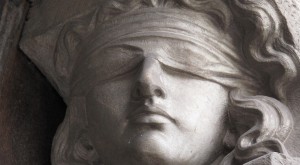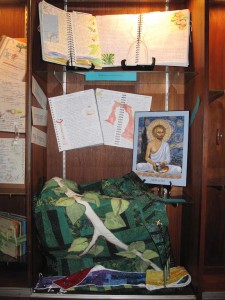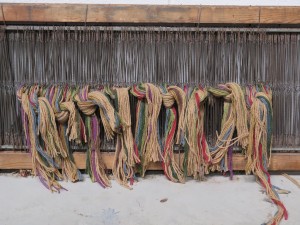As a clergywoman – even one who no longer ministers in a parish – my life is interwoven with symbols and symbolism…with those things that literally ‘bind together’ (sym-bolen, to throw together.) Vestments are symbols; paraments are symbols; chalices and patens and crosses are symbols. The language of rites and sacraments is metaphor (which is verbal symbolism). Ritual acts like putting drops of water (or ashes) on someone’s forehead is a form of kinetic symbolism. In my vocation, one does not take a symbol lightly nor does one say that something is ‘only’ a symbol or ‘only’ a metaphor or ‘only’ a ritual. There is no ‘only’ about any of it. Meaning twines around and through every thing we do and say.
Which is why clergy (and artists and poets) know that we need to tread very very gently around objects like crosses, and hijabs…and flags.
The day after 9/11 (when I was just beginning the second week of my first interim ministry position), colleagues across the country walked into the sanctuaries of their churches to discover that the sexton, or deacon, or church secretary, or head of the local Veterans organization, or Scout leader, or other well-intentioned parishioner or staff member had planted an American flag directly behind the communion table, or beside the pulpit, or in front of the altar where it promptly created divisive conflict in the congregation. Over the next weeks and months and (in some cases) years, everyone on all sides of the conversation (or shouting match, depending on the situation) agreed on one thing: that particular piece of cloth, imprinted or sewn with those particular stars and stripes, was a symbol of breath-taking power which could unite or divide depending on how it was used.
So while I am troubled, I am not surprised that we are watching a similar battle play out in South Carolina. But before I tell the people of South Carolina how to get their act together, it might be fruitful to consider at least one of the symbols in my own landscape of meaning that has been every bit as destructive as any Confederate flag. Rather than shaking my head in disbelief at the Sons and Daughters of the Confederacy, perhaps I could better use the time acknowledging my own need for repentance around, for instance, the symbol of the communion table.
In recent years, the discussion has become more than a little heated in ecumenical circles about who gets to participate in the meal held around that table. As a clergywoman, I carry some scars from this battle. I hold dual-standing in two denominations that recognize the ordination of women (which is or is not allowed by scriptural authority depending on which group of scholars you ask), but that does not mean I can officiate just anywhere. And who is authorized to officiate is only part of this situation. The second part is who gets to partake.
It may seem like a no-brainer to an outside observer. After all, the communion table is the place where we remember the life and celebrate the ministry of Jesus of Nazareth. The purpose of gathering at the table is to empower ourselves through the symbolic act of sharing bread and wine to continue that ministry until the whole universe is united in the peace of at-one-ment with God and with neighbor. Given that mandate, it is obvious that this table is open to everyone.
No, no. Wait a minute. Depending on which church you are standing (sitting, kneeling) in, this table is actually not open to everyone. The very sacrament that was given to his companions by the man who scandalized his own religious leaders and provoked loud and violent discussions in his own day and place by eating with the unclean and the outcast, is being denied in many congregations and sects to those who are not part of the inner circle (defined differently depending on who is doing the defining.)
So, one of the central symbols of the faith: enacting the future vision of the divine banquet which is the holy nexus, the sacred gathering place, of the height and depth and breadth of the universe, is actually dividing creation rather than uniting it. In some architecture, there is even a railing that serves as a visible reminder that lots and lots and lots of created beings are excluded. Sometimes, excluded painfully, harshly, judgmentally; rejected as unworthy; occasionally even publicly shamed by the exclusion.
 Which brings me to a dawning awareness: if I am going to be clearing the material clutter out of my life, it is probably equally important to clear out the emotional and psychological clutter. It is going to be necessary to look at the symbols I give heart and head room to, both the ones I keep on a prominent shelf in my inner space, and the ones that have gotten shoved under the bed, out of sight. If my life is going to be clearer and cleaner, more integrated and more authentic, I am going to need to release not only the clothes that no longer fit, but the ideas (and judgments and prejudices) that no longer fit.
Which brings me to a dawning awareness: if I am going to be clearing the material clutter out of my life, it is probably equally important to clear out the emotional and psychological clutter. It is going to be necessary to look at the symbols I give heart and head room to, both the ones I keep on a prominent shelf in my inner space, and the ones that have gotten shoved under the bed, out of sight. If my life is going to be clearer and cleaner, more integrated and more authentic, I am going to need to release not only the clothes that no longer fit, but the ideas (and judgments and prejudices) that no longer fit.
Two days ago, when I was beside myself over the Confederate flag outside the South Carolina capitol, I started a list in my journal as a way of channeling my anger in a direction about which I can effectively do something. I started to list the symbols in my own life that I would justify or defend with passion and righteous indignation. Not with a gun, no, but a gun is not the only weapon that can wound someone, or kill a soul.
In the spirit of peace and humility and compassion, I invite you to join me this week (and next week, and the week after that) in looking at the symbols that shape your life. The visual, verbal, and kinetic metaphors that burrow deep into your emotions, that provoke anger or fear or passion or righteousness. We all have them in abundance: from a family heirloom that represents our special place in the family to the seat we take at the dinner table, from the car we drive to the tattoos we choose, from the organizations we join (some with symbolic clothing or jewelry) to the logos or uniforms we wear (from jeans and hoodie, to a white coat with stethoscope, or shoes with a swoosh, or dark suit and tie), from the art on our walls to the credit cards we carry. We call some of these things status symbols for a reason.
May we be wise.
May we be compassionate.
May we be humble.
May we give up,
heart, mind, and body,
the knife-edged desire to
know meaning
in the de-meaning of another.
May we give ourselves,
heart, mind and body,
to be woven
into the uniting web of creation.
Thus may we become
living symbols
of the shalom vision.
–Andrea
Text © 2015, Andrea La Sonde Anastos
Photos © 2015 Immram Chara, LLC


